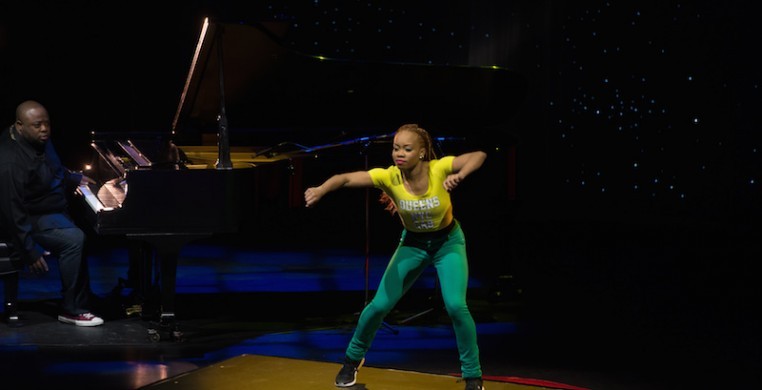There was a test early on for the Queens-based* choreographer Camille A. Brown. Brown—who is small in stature but big when it comes to ideas—grappled with the title of her new piece, “BLACK GIRL: Linguistic Play,” now receiving its Chicago premiere by Camille A. Brown & Dancers at the Dance Center of Columbia College, thinking theaters would be reluctant to present something that was so suggestive. She moved forward, anyway, banking on her instincts. It wasn’t just the smart choice; it was the right choice. (In a post-performance Q&A she spoke about how she anticipated seeing who would show up for the show—black, white, purple, whatever—if only to see how the title would influence prospective ticket buyers.) For the still-skeptical presenters out there, if there are any left, it’s not too late to reverse course.
A later test for “BLACK GIRL” was to do it without any dialogue. “BLACK GIRL” is, at its heart, a show about identity—what is it? Where does it come from? And, for Brown, how does it reveal itself? It’s a familiar construct of nature vs. nurture. Brown, a Bessie Award winner, attempts to answer these questions by going back to the impressionable days of childhood. She shapes her child play based on popular games like Double Dutch and the playground rhyme Gigolo (“My hands up high, my feet down low, this is how I Gigolo!”), sibling rivalries, and harkening back to what might be described as the good ol’ days. She and her playmates, or sisters as she referred to them afterward, stomp in sneakers with percussive force, rumble with the indefatigable intensity of children, venturing into the realm of friendship and even mother-daughter dynamics. In three separate duets, every game/encounter creates a touching narrative arc—some of it freely energetic, other times tender and light.
The purpose here has Brown looking closely at her own reflection (literally, in fact, as the set design by Elizabeth C. Nelson features hanging mirrors and elevated stage boards), but also at cultural and social stereotypes. They play a prominent role in “BLACK GIRL,” what Brown astutely perceives as something earned and, at times, forced by outside sources like film and the media, for example. “Do all black girls play Double Dutch?” she seems to ask. Well, some, but so do some white girls. So do some Asian men, etc. Brown’s challenge to the audience is to let them decipher these nuances in their own way, confronting preconceived tropes shining light on our biases without forcing the point. It’s a remarkable achievement made all the more memorable with wonderful live accompaniment from pianist Justin Ellington and electric bassist Tracy Wormworth.
Back to the Q&A, which concludes this performance and is less of a choice than it is part of Brown’s artistic pursuit: It’s a surprisingly humbling experience, if you’re lucky enough to catch this performance over the next few days. I kept thinking back to one of the few scenes with spoken text, a sprightly Brown rhyming in singsong fashion, “My name is Cami, and I am small, but when you see me, I am TAAALLLLL!” For someone who describes herself as small, she packs quite the marvelous punch.
*An earlier version of this review misstated that Camille A. Brown is a Brooklyn-based artist; she is Queens-based.

